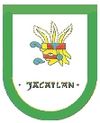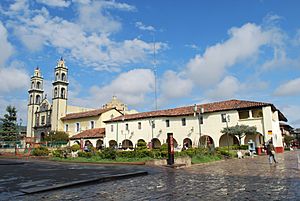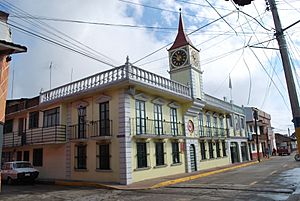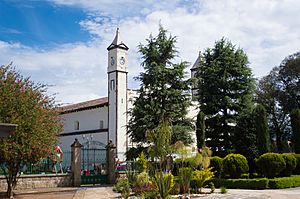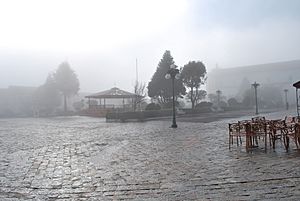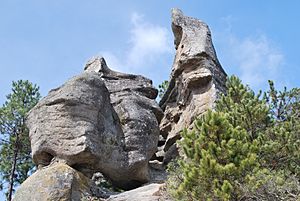Zacatlán facts for kids
Quick facts for kids
Zacatlan
|
||
|---|---|---|
|
City
|
||
| Zacatlan de las Manzanas | ||
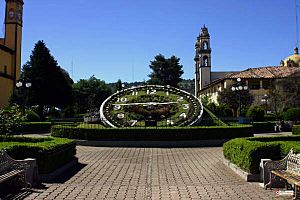
Main plaza with flower clock
|
||
|
||
| Country | ||
| State | Puebla | |
| Founded | 1562 | |
| Municipal Status | 19th century | |
| Elevation
(of seat)
|
2,000 m (7,000 ft) | |
| Population
(2010) Municipality
|
||
| • Municipality | 76,296 | |
| Time zone | UTC-6 (Central (US Central)) | |
| • Summer (DST) | UTC-5 (Central) | |
| Postal code (of seat) |
73310
|
|
| Area code(s) | 975 | |
| Demonym | Zacatecos | |
| Website | [1] | |
Zacatlán is a city in central Mexico, located in the Puebla state. Its name comes from the Nahuatl language and means "place of zacate grass." The city is also known as "Zacatlán de las Manzanas," which means "Zacatlán of the Apples," because of the many apple orchards in the area.
Zacatlán is famous for its apples, other fruits, and delicious fruit drinks like cider and fruit wines. These products are celebrated every year at the Apple Fair and Cider Festival. The city is also home to Relojes Centenario, the first clock factory in Latin America. This company built the famous double-sided flower clock in Zacatlán's main square.
The historic center of Zacatlán has many old houses with red tile roofs. In 2011, Zacatlán was named a "Pueblo Mágico" (Magical Town) because of its beauty and traditions. Outside the city, you can find the amazing Piedras Encimadas Valley with its unique rock formations, and several beautiful waterfalls and deep ravines.
Contents
Exploring the City of Zacatlán
The city of Zacatlán sits high up at 2,000 meters (about 6,560 feet) above sea level. It is in the Sierra Norte de Puebla region, about 130 kilometers (80 miles) from the state capital, Puebla City. The main ways people make a living here are through farming and trade.
The city is located next to the Ajajalpan River, which flows into the Gulf of Mexico. Zacatlán is surrounded by hundreds of thousands of apple and other fruit trees. When the trees bloom, the air fills with their sweet smell. The old part of the town has large, traditional houses, some over a hundred years old. They have sloped roofs covered with red clay tiles and stone-paved streets.
The Main Square and Flower Clock
The heart of Zacatlán is its main square, which has a kiosk where live music is played on Sundays. But the most famous feature is its incredible flower clock. This clock was made by the Centenario Clock company.
The flower clock has two faces, each five meters (about 16 feet) across. What makes it special is that it's the only double-faced flower clock where both sets of hands are moved by just one mechanism!
Important Buildings in the City Center
On one side of the main square is the municipal palace, which is the local government building. It was built in 1876 and has a beautiful Neoclassical style. Its front has seventeen arches, each with the name of a community that helped build it.
Across the square is the old Franciscan monastery. It was founded in 1567 and was very important for spreading Christianity in the area. This monastery is the oldest building of its kind in the state of Puebla. The church inside has been used continuously since it was built, which is unique in Latin America.
In the monastery's courtyard, there is a fountain called the Fuente de las Sirenas (Fountain of the Mermaids). After many years of being empty, the monastery was restored in the 2000s. During this work, old murals from the colonial era were found on the inside walls. These murals show images of deer, bees, jaguars, houses with straw roofs, and daily life scenes with both Spanish and indigenous people.
The San Pedro parish church is close to the monastery, just off the main square. It is a Renaissance-style church. Its main entrance dates back to 1564. The front of the church has a sculpture of Saint James the Greater. He is flanked by angels wearing Totonaca-style loincloths and boots. The main doors are made of wood. The Virgin of Guadalupe chapel inside has beautiful gold leaf work and many oil paintings by local artists. In the dome, you can see portraits of the Four Evangelists.
Centenario Clock Company and Museum
Zacatlán is known for its clever inventors. One of the most famous is Alberto Olvera Hernandez, who started the Centenario Clock company. Alberto grew up on a farm and became interested in clocks after fixing a broken one. He taught himself how to build clocks, even making his own tools.
He began selling clocks in 1909. In 1918, at just seventeen years old, he built his first huge clock. This led him to open Centenario, the first clock factory in Latin America, which specializes in large, monumental clocks. These clocks have been placed in buildings, parks, and plazas in Mexico and other countries.
One of the first clocks Alberto made is over eighty years old and still works in a church tower in Chignahuapan. Today, you can find Centenario clocks all over Mexico. The factory's most famous creation is the flower clock in Zacatlán's main square.
Today, the Centenario factory employs about fifty people and welcomes visitors. On the top floor, there is a clock museum that opened in 1993. It is dedicated to Alberto Olvera Hernandez and displays original and replica timepieces from throughout history, including those using water, sun, sand, and candles.
Local Culture and Festivals
The city's cultural center has a Regional Museum. It displays ancient artifacts from a local ceremonial site. It also has weapons from the Mexican War of Independence and the autopsy report of Venustiano Carranza, an important figure in Mexican history.
The main annual event in Zacatlán is the Feria de la Manzana, or Apple Fair. It has been held every August since 1941. This week-long event attracts about 300,000 visitors. It offers around 140 different activities, including:
- Crowning an Apple Queen
- A clock exhibition
- Food stalls
- Other exhibits
- Concerts by symphony orchestras and popular artists
A local dance called Zacatlán de la Manzanas, created by musician Pedro Escandon, is performed here. The festival usually sells over 100,000 crates of apples, plus hundreds of crates of plums and pears. The festival honors Our Lady of the Assumption.
Another big apple event is the Cider Festival in November, which draws about 10,000 visitors each year. The town produces about a million bottles of cider annually, using about 10,000 tons of apples. The festival also promotes other local products like jams, soft drinks, preserved fruits, and other fruit wines.
The Festival Cuaxochitl, held in May, celebrates the area's indigenous cultures.
Local Delicacies
A special local food is a cheese-filled bread, which is sold only in Zacatlán.
History of Zacatlán
The name Zacatlán comes from the Nahuatl language, meaning "place of zacate grass." The Spanish part, "de las Manzanas," means "of the apples," referring to the many apple trees. The city is also known as Zacatlán de Marques Galindo and San Pedro Zacatlán.
The first people to live in this area were the Zacateca tribe around 583 AD. Later, in 1115, the Chichimecas took control. Eventually, the area became part of the Aztec Empire.
After the Spanish conquest of the Aztec Empire, Spanish soldiers took over the land. In 1522, the native people were moved to different locations. Finally, in 1562, they were moved again to establish what is now Zacatlán. The Franciscans built a monastery and cemetery here.
Apple farming was introduced in the early 17th century and has been a major part of the local economy ever since.
During the Mexican War of Independence, Zacatlán helped the cause by making weapons and coins. After Mexico gained independence in 1825, Zacatlán became an important administrative center.
The city was even the seat of government for the state of Puebla in 1847 during the Mexican American War. Because of this, it was given the title of "city" that same year.
In the late 2000s, the old monastery complex was carefully restored. Before this, it was almost completely abandoned. The restoration work led to the discovery of the beautiful colonial murals inside.
The city invested a lot of money to earn the "Pueblo Mágico" (Magical Town) title in 2011.
Geography and Natural Wonders
Zacatlán is located in the southwest of the Sierra Norte de Puebla mountains. The landscape has individual mountains mixed with large and small flat areas. There are also caves in the mountains. Most of these flat areas slope towards the eastern coast and the Gulf of Mexico.
The municipality itself is in a large flat area, about 14 km (9 miles) long and 9 km (5.6 miles) wide. Its average height is 2,500 meters (about 8,200 feet) above sea level.
Rivers and Waterfalls
The area's rivers flow towards the Gulf of Mexico. Because the land is rugged, there are many small, fast-flowing rivers. The Ajajalpan River is one of the main rivers here. It forms part of the municipality's border. Other rivers include the Tulimán, Hueyapan, and San Pedro.
The rugged land also creates beautiful waterfalls, like the Tulimán waterfall. This is the tallest waterfall in the area, estimated to be between 250 and 300 meters (820 to 984 feet) high. It is located about forty minutes outside the main city.
The Los Jilgueros Ravine is near the community of Atmatla, about three kilometers (1.8 miles) from the city. It's an area of pine forests with the San Pedro River cutting a small canyon up to 400 meters (1,300 feet) deep. The ravine has features like the Espinazo del Diablo (Devil's Spine) and the Balcón del Diablo (Devil's Balcony), which offers views of large rock formations that look like human figures, called Los Frailes (The Friars). It also has the San Pedro waterfall, about twenty meters (65 feet) high, where you can swim.
Climate and Nature
Zacatlán has a cool, damp climate for most of the year. The average yearly temperature is between 12°C and 18°C (53°F and 64°F). It rains all year round, and fog is common most mornings and nights, sometimes very thick.
The municipality has large areas of conifer forests, mostly pine trees. There are also areas with a mix of pine and oak trees, and some with semi-tropical plants. The largest forests are in the center, north, east, and far west.
The Piedras Encimadas Valley is located in San Miguel Tenango. It is a private area covering over 300 hectares (about 740 acres). Legends say the rocks were giants turned to stone by an ancient god. Other stories suggest the area was once under the sea or that aliens made them.
These rocks are over 65 million years old, formed by volcanic activity. Over time, wind, rain, and chemical reactions have shaped them into their current forms, some reaching up to twenty meters (65 feet) tall. Many of the rock structures look like humans, columns, castles, monsters, or animals. Piedras Encimadas offers camping, extreme sports, and horseback riding.
Economy and Local Products
Zacatlán has a high level of socioeconomic marginalization, meaning many people face economic challenges. Most homes have wooden walls and cement floors, with roofs of clay tile or brick. Basic services like running water, electricity, and sewage are most common in the main city. Many rural communities lack sewage, public lighting, and garbage collection. The economy in rural areas relies on farming and people moving to other places for work.
Farming and Livestock
Most of the municipality's land is used for farming. The main crops are beans, corn, fava beans, wheat, apples, plums, peaches, pears, and walnuts. Other important crops include potatoes, garlic, and barley. Zacatlán has been a major producer of apples since the 1600s.
The city is surrounded by an estimated 700,000 apple trees, 300,000 plum trees, and 150,000 pear trees. Livestock farming mainly involves cattle and sheep for wool, along with some mules and chickens. Some communities also raise fish like trout and carp. Beekeeping is also practiced. Trees are harvested for making furniture and building materials. These activities employ 47.2% of the working population.
Industry and Crafts
Most industries are small factories and workshops. They produce apple cider and other fruit wines, pottery, fireworks, processed coffee, and breads. The most famous factory is the Centenario Clock factory in the city. Making fruit wines and dried fruits helps support the farming community.
Zacatlán processes about 10,000 tons of apples to make cider. About eighty percent of this cider is sold in December for the holidays, mostly in central and southern Mexico. Four main companies dominate cider production, directly employing forty families and indirectly benefiting 200 families involved in apple growing and sales.
Local crafts include making sarapes (blankets), overcoats, quexquémetls (traditional garments), wooden tools, and pottery. The community of San Miguel Tenango is known for its items made from ixtle fiber. Zacatlán also makes glass Christmas ornaments, with the Martínez Luna family being a main producer. There are ten other workshops in the city.
The area also has deposits of minerals like manganese, iron, quartz, gold, silver, and copper. These industrial activities employ 17.9% of the working population.
Commerce and Tourism
Zacatlán has two weekly markets, one traditional fixed market, and 724 other shops. Most businesses serve local needs, but there is a small tourism industry. This is mainly focused on the city itself and the Valley of the Piedras Encimadas. Tourism outside the city is mostly about enjoying nature (ecotourism).
Piedras Encimadas offers camping, extreme sports, and horseback riding. The Tulimán waterfall area has recreational facilities like cabins, palapas (open-sided dwellings), and a zip line. Commerce, services, and tourism employ 31.5% of the working population.
See also
 In Spanish: Ciudad de Zacatlán para niños
In Spanish: Ciudad de Zacatlán para niños


